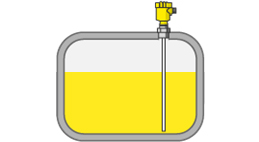Sensors: capacitive
A simple capacitor principle makes an economical choice
So, you're planning something more sophisticated than a dip stick to take tank measurements. But no-one told you there were so many types of gauge / sensor. Which do you choose?
A simple capacitive solution might be all you need.

Capacitive (RF) sensors
A capacitor is a pair of electrically insulated electrodes which hold a charge between them. The dielectric constant of the substance between the two electrodes affects the charge being stored.
If the substance in the tank has a different dielectric constant from air then a capacitive sensor will detect how much of the space between the electrodes is filled with the substance at it rises and falls. It does this by applying a radio frequency (RF), which gives this technique its other name.

A Vegacal capacitive sensor in a tank
What capacitive can sensors do
These are robust, inexpensive and versatile sensors. Indeed, if you just want to measure petroleum products or water then you should find a capacitive sensor that suits you.
Take care that you don't allow static build-up to create a hazard; always have your sensor fitted by a professional.
Connecting to HyDip
One thing to remember, however, is that whichever sensor you've installed it's as easy as wiring up a block plug and snapping it into place on your HyDip device to get it talking to your laptop. Read more about HyDip online tank management here.
Which gauge for you?
Selecting the right gauge for your situation can require discussion and thought. Cost, suitability, ease of installation and accuracy are just some of the factors that figure in a decision.
As well as guided wave radar / TDR gauges your choices include:
Updated 11 months ago
